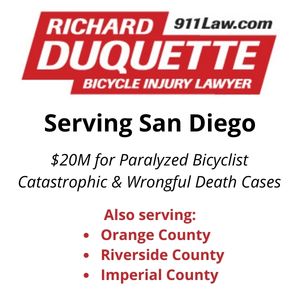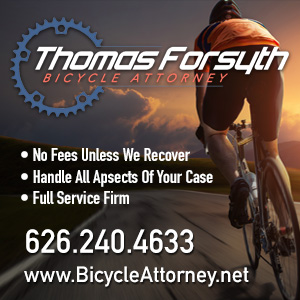It’s not every day you get a chance to save a life.
But that’s exactly what you can do in the next few minutes. Without moving from wherever you are right now.
Chances are, you’ll never know when it happens.
It could be a young child who doesn’t get hit by a car on her way to school, thanks to a safe crosswalk on a dangerous intersection. Or one who doesn’t develop diabetes or other obesity-related illnesses because he can to safely ride his bike in his own neighborhood.
Or it could be you, benefitting from the same improvements that help keep countless area children and their parents safe as they walk or bike to and from school.
In fact, the life you save could be virtually anyone, and everyone. And all you have to do is take a few moments right now to endorse the Southern California Regional Platform developed by Safe Routes to School California.
I’m not asking you to do anything I wouldn’t do. In fact, you’ll find me right here, along with other names you may recognize, representing people and groups throughout the area.
They’re out to get 75 endorsements by May15th. Personally, I think we can do a lot better than that. I’d like to see at least 75 endorsements by the end of this week. And a few hundred more by the May 15th deadline.
If even just a fraction of the people who visit this blog every day sign up, we can easily meet that goal. And make a real difference in the health and safety of children and adults throughout Southern California.
So if you bike or walk in Los Angeles — or care about children who do — stop whatever you’re doing and take just a couple minutes to click this link and endorse the Safe Routes to School platform.
Please.
.………
Speaking of Safe Routes to Schools, the Santa Monica chapter says there’s a big, gaping Trench of Doom blocking access for students at Santa Monica High. Evidently, there used to be a pedestrian and bike bridge over the Santa Monica freeway, which — despite what one councilmember recalls — was removed to make room for a new off ramp.
And they want it back.
Although personally, I think a park would be a better option there.
.………
Here’s the next bike book I want to read. Olympic medalist and TdF stage winner Davis Phinney writes about his riding career and battle to overcome Parkinson’s disease, as well as raising a rising pro riding phenom in his son Taylor.
Phinney used to lead rides around Denver and Boulder with his wife, fellow Olympian Connie Carpenter, that I fell in with on more than one occasion. So I like to say I’ve ridden with them — even though he probably never knew I was there at the end of the pack.
He’s also one of the few people I’ve never heard anyone say a single negative word about.
.………
Still no charges in the hit-and-run death of Encino endurance cyclist Jim Swarzman; a sheriff’s spokesman confirms that alcohol may have been a factor, as many people have speculated.
.………
A Topeka, Kansas lawyer has his license suspended after pleading No Contest in the DUI death of a local cyclist. Blood tests showed he had a .12 BAC, as well as marijuana, a “narcotic-like pain reliever” and an antidepressant in his system — and was driving in that state with his own son in his car. It was his 4th DUI since 1989, and third since 2000. Thanks to Stanley Goldich for the heads-up.
.………
Zev talks bikes and trains, or more precisely, bikes on trains. Although rumor has it that Metro’s commitment to put bikes back on trains may not be as strong as they suggest, so Thursday’s meeting of the Metro Board’s Operations Committee could turn out to be important.
There also may be some pushback on plans to remove seats to make room for bikes, as well as strollers, shopping and suitcases, all of which can block doorways and turn into projectiles if left in aisles.
.………
If you’re 12 -18, you can earn a bike at Bicycle Kitchen; if you’re too old for that, join the volunteers at Bikerowave. LACBC offers flyers explaining the upcoming road diet on Downtown’s 7th Street. Streetfilms looks back at the recent CicLAvia. Cynergy Cycles is offering an introduction to cycling lecture on Wednesday, and will soon feature a blog of their own. KPCC reports on how to get a bike lane or corral on your street. LADOT Bike Blog examines the long history behind the recently opened Elysian Valley segment of the L.A. River Bike Path. The Source looks forward to next month’s Bike to Work Week. L.A. Creek Freak suggests a visit to the double parentheses of Burbank’s Lake-Providencia Bridge. Bikeside’s Mihai Peteu calls for better — aka separated — bike lanes; Long Beach officially opens theirs on Saturday. The Long Beach City Council takes up the cause of naming the bike paths on the new replacement for the Gerald Desmond bridge for late bike advocate Mark Bixby. Bike and dine at a discount on Earth Day in Long Beach. San Diego magazine looks at the rise of citizen cyclists. The Golden Gate Bridge considers a 10 mph speed limit — and a ban on tall bikes and unicycles. The Art of the Group ride looks at the recent list of bike friendly universities, and concludes that smart people ride bikes.
The Economist says distracted driving is the new drunk driving. Green bikeways finally receive preliminary approval from the Feds. Bicycling interviews cycling actress Monica Raymond of Lie To Me. A woman fantasizes about fighting back when she gets right hooked. Vulnerable user laws gain speed across the country. Apparently, a Portland coffee shop doesn’t love cyclists anymore. Motor-centric Indianapolis will add 33 miles of bike lanes this year alone. A Kentucky jury gets it, as they sentence a drunk driver to 35 years for the death of an 11-year old bike rider. Listen my children and you shall hear of bike routes that follow the midnight ride of Paul Revere. A commenter deftly dismantles the NY Posts latest anti-bike diatribe, while BikeNYC offers photographic proof that the city’s traffic-clogged streets are just a myth, and are actually occupied only by bike riders. Robin Williams gets stopped as part of NYC’s bike crackdown, while talk show host Chelsea Handler reportedly finds dead cyclists amusing. The New York Times discovers Japan’s post-earthquake bike boom. A Virginia campaign urges drivers to be bike friendly. NASCAR driver and cyclist Bobby Labonte is hosting a Share the Road Memorial Ride in North Carolina this weekend to honor fallen cyclists; thanks to Todd Munson for the heads up.
A stabbing victim feels police don’t care, comparing it to reporting a stolen bike; now that hurts. A writer takes the UK’s Automobile Association to task for their recent bike helmet and hi-vis vest handout, rather than focusing on dangerous drivers. London cyclists complain about the city’s ghost bike lanes. Everyone cycles in Antwerp. Pro teams walk out on a meeting with UCI President McQuaid in a dispute over race radios. Plans to remove parking spaces to put in bike lanes have Tel Aviv residents up in arms, who see it as an attempt to turn the city over to the rich; evidently, poor people must not ride bikes in Israel. Pietro Ferrero, CEO of the company that brings you Nutella and Ferrero Rocher died after falling from his bike in South Africa. Philippine cyclists campaign for cleaner air.
Finally, a 72-year old Aussie cyclist says red lights are a bloody hindrance. Maybe he’d like the new brakeless bike from Target, although he may need the Army’s new Kevlar bike shorts if he keeps running them.





